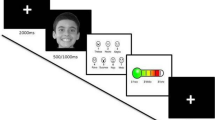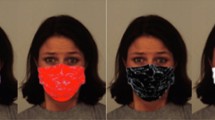Abstract
This paper intends to contribute to the research on the perception of emotion with a case study on the recognition of realistic vs. stylized facial emotional expressions in typical developing three and six-year-old children. In particular, it reports on two perceptual experiments aimed at evaluating children’s ability in identifying human and stylized male and female facial emotional expressions of happiness, anger and surprise. Results show that six-years-old children are able to recognize facial expressions of happiness and anger exploiting stylized as well as realistic human figures, preferring stylized faces for the identification of surprise. Three-year-old children are not able to recognize surprise and are significantly better in recognizing happiness rather than anger, suggesting that the ability to recognize certain emotional faces emerges through experience. In addition, it also suggests that this ability is not affected by face gender.
Access this chapter
Tax calculation will be finalised at checkout
Purchases are for personal use only
Preview
Unable to display preview. Download preview PDF.
Similar content being viewed by others
References
Baron-Cohen, S.: The extreme male brain theory of autism. Trends Cogn. Sci. 6, 248–254 (2002)
Boni, L.C., Brown, R.T., Davis, P.C., Hsu, L., Hopkins, K.: Social information processing and magnetic resonance imaging in children with sickle cell disease. Journal of Pediatr. Psychol. 26, 309–319 (2001), doi: 10.1093/jpepsy/26.5.309
Brüne, M.: Emotion recognition, “theory of mind,” and social behavior in schizophrenia. Psychiatry Res. 133, 135–147 (2005)
Celani, G., Battachi, M.W., Arcidianoco, L.: The understanding of emotional meaning of facial expressions in people with autism. Journal of Autism and Developmental Disorders 29(1), 57–66 (1999), doi:10.1023/A:1025970600181
Davis, W.: Expression of Emotion. American Philosophical Quarterly 25, 279–291 (1998)
Denham, S.A.: Emotional development in young children. Guilford Press, New York (1998) ISBN 1572303522
de Rosnay, M., Hughes, C.: Conversation and theory of mind: Do children talk their way to socio-cognitive understanding? Journal of Developmental Psychology 24(1), 7–37 (2006)
Ekman, P., Friesen, W.V., Hager, J.C.: The facial action coding system, 2nd edn. Research Nexus eBook, Weidenfeld & Nicolson, Salt Lake City, London (2002)
Ekman, P.: An argument for basic emotions. Cognition and Emotion 6, 169–200 (1992)
Ekman, P.: The argument and evidence about universals in facial expressions of emotion. In: Wagner, H., Manstead, A. (eds.) Handbook of Social Psychophysiology, pp. 143–164. Wiley, Chichester (1989)
Ekman, P.: Expression and the nature of emotion. In: Scherer, K., Ekman, P. (eds.) Approaches to Emotion, pp. 319–343. Lawrence Erlbaum, Hillsdale (1984)
Esposito, A.: The Perceptual and Cognitive Role of Visual and Auditory Channels in Conveying Emotional Information. Cognitive Computation Journal 1(2), 268–278 (2009)
Herba, C., Phillips, M.: Annotation: Development of facial expression recognition from childhood to adolescence: behavioural and neurological perspectives. Journal of Child Psychology and Psychiatry 45(7), 1185–1198 (2004), doi:10.1111/j.1469-7610.2004.00316.x
Izard, C.E.: Basic emotions, relations among emotions, and emotion–cognition relations. Psychological Review 99, 561–565 (1992)
Pons, F., Lawson, J., Harris, P., de Rosnay, M.: Individual differences in children’s emotion understanding: Effects of age and language. Scandinavian Journal of Psychology 44(4), 347–353 (2003)
Pons, F., Harris, P.: Test of emotion comprehension: TEC. Oxford University, Oxford (2000)
Scherer, K.R.: The role of culture in emotion-antecedent appraisal. Journal of Personality and Social Psychology 73, 902–922 (1997)
Scherer, K.R., Banse, R., Wallbott, H.G., Goldbeck, T.: Vocal cues in emotion encoding and decoding. Motivation and Emotion 15, 123–148 (1991)
Scherer, K.R.: Vocal correlates of emotional arousal and affective disturbance. In: Wagner, H., Manstead, A. (eds.) Handbook of Social Psychophysiology, pp. 165–197. Wiley, New York (1989)
Johnson, M.H.: Subcortical face processing. Nature Reviews Neuroscience 6, 766–773 (2005)
Turati, C., Macchi Cassia, V., Simion, V., Leo, I.: Newborns’ face recognition: role of inner and outer facial features. Child Development 77, 297–311 (2006)
Grizzle, J.E.: Continuity Correction in the χ 2 Test for 2×2 Tables. The American Statistician 21, 28–32 (1967)
Adams, A., Robinson, P.: An Android Head for Social-Emotional Intervention for Children with Autism Spectrum Conditions. In: D’Mello, S., Graesser, A., Schuller, B., Martin, J.-C. (eds.) ACII 2011, Part II. LNCS, vol. 6975, pp. 183–190. Springer, Heidelberg (2011)
Author information
Authors and Affiliations
Corresponding author
Editor information
Editors and Affiliations
Rights and permissions
Copyright information
© 2013 Springer-Verlag Berlin Heidelberg
About this chapter
Cite this chapter
Esposito, A., Riviello, M.T., Capuano, V. (2013). Discriminating Human vs. Stylized Emotional Faces: Recognition Accuracy in Young Children. In: Apolloni, B., Bassis, S., Esposito, A., Morabito, F. (eds) Neural Nets and Surroundings. Smart Innovation, Systems and Technologies, vol 19. Springer, Berlin, Heidelberg. https://doi.org/10.1007/978-3-642-35467-0_39
Download citation
DOI: https://doi.org/10.1007/978-3-642-35467-0_39
Publisher Name: Springer, Berlin, Heidelberg
Print ISBN: 978-3-642-35466-3
Online ISBN: 978-3-642-35467-0
eBook Packages: EngineeringEngineering (R0)




